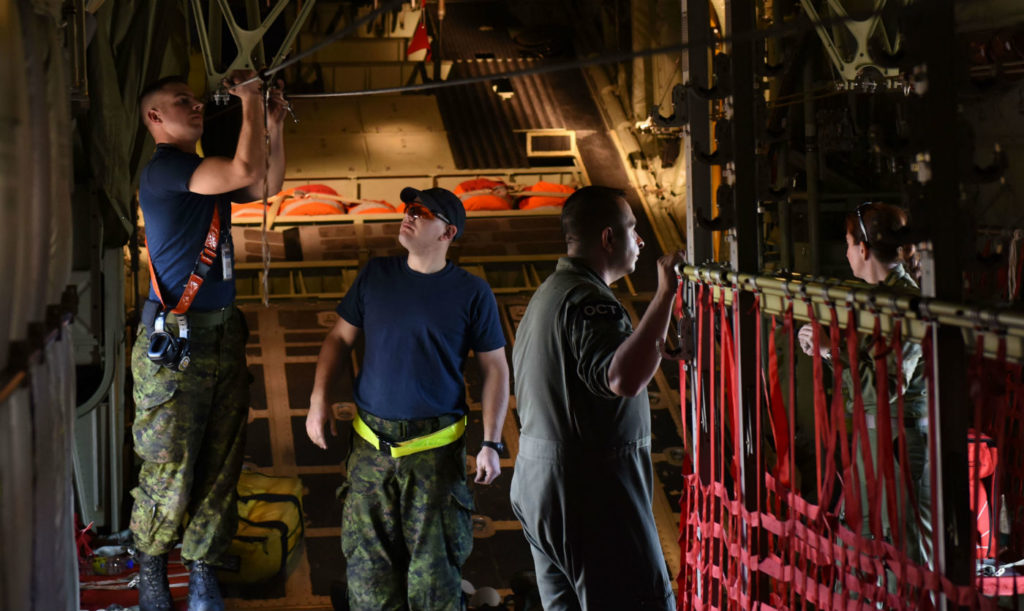Estimated reading time 6 minutes, 5 seconds.
Seventy-one personnel from 8 Wing Trenton, Ont., including members of 436 Transport Squadron, travelled to Little Rock, Ark., and Alexandria, La., to take part in Exercise Green Flag Little Rock (GFLR) 17-04 from Feb. 7 to 19, 2017.

Hosted by the United States Air Force’s 34th Combat Training Squadron, the exercise involved approximately 4,300 personnel from six USAF bases, the U.S. Army, the U.S. Marine Corps, the British Army and the Royal Canadian Air Force in a scenario-based, highly dynamic coalition event.
“Developing aircrews and all support personnel to operate more effectively with our allies is one of the things we look forward to when we participate in GFLR,” said Maj Gerald Fraser, 436 Transport Squadron’s deputy commanding officer and the Canadian detachment commander during the exercise. “I’m looking forward to seeing our younger personnel return with more experience in different and challenging roles.”
Exercise participants were graded on all aspects of their operations from maintenance and air movements support to intelligence gathering to aircrew performance.
With the support of the maintenance, intelligence, air movements, operations cell and other support assets, 436 Squadron’s four flying crews performed exceptionally well, taking home the two top awards from the competition: the “Top Cat Award” for the top performing crew and the “An Lộc Memorial Award” for best airdrop (named in honour of a 1972 Vietnam battle where air-borne supplies played a vital role in turning the tides of the war).
One of the loadmaster crews was recognized for having the highest grade for their performance and the four Canadian crews ranked first through fourth out of the 14 aircrews that participated.
The exercise’s missions included personnel and cargo airdrops, formation flying, austere landings, low-level tactical flying, and engine running operations to on-load and off-load cargo. These missions took place 24 hours a day, with night vision goggles being used for all night operations.
The event also tested survival, resistance, evasion and escape (SERE) skills with unannounced SERE events taking place throughout the exercise. While carrying out routine activities, the aircrew was surprised when SERE specialists pulled up alongside the aircraft informing them to swiftly gather their bags. As in real-world situations, when an aircraft goes down the aircrew have no idea it’s coming.
“We took a group of pilots [who expected] to do airdrops and took them off their schedule and deep into the woods. We put their previous training and skills to the test and evaluated them,” said Staff Sgt Jonathan Peavey of the United States Air Force, a SERE specialist.
In total, 436 Transport Squadron air dropped 215 paratroopers and 38,000 pounds of cargo during the exercise; an additional 155,000 pounds of cargo was transported between staging bases and austere landing strips.

LCol Zan Sproles, exercise director for the 34th Combat Training Squadron, said that GFLR interplays with a larger training objective and underlines the importance of training Allies training together.
“Green Flag is not just an exercise, it is just one component of a larger joint training scenario . . . conducted by the U.S. Army’s Joint Readiness Training Center and their objective is to validate a rotational training unit’s ability to achieve their assigned mission in defence of national objectives.” (In the American forces, a “rotational training unit” is in the training cycle to become the next high readiness or deployed unit.)
“Unilateral operations, whether combat or non-combat, are something of the past; joint and coalition operations are now the standard,” he continued. “The benefit of inviting international partners to our exercises allows us to work out our different operational constraints and interoperability issues while in a training venue.”
“This is the only joint training scenario in the United States that combines land, air mobility, and combat air forces in a relevant, rigorous, multi-echelon training that develops and enhances joint readiness,” he continued.
“No two exercises are the same and that helps the mobility enterprise by continuing to challenge their warfighting skills while providing real-world experiences with partners they may not be able to get with home-station training,” said Col Charles Brown, commander of the 19th Airlift Wing.
Capt Marrin is a pilot with 436 Squadron.
With files from Senior Airman Stephanie Serrano and Senior Airman Mercedes Taylor, 19th Airlift Wing Public Affairs.








